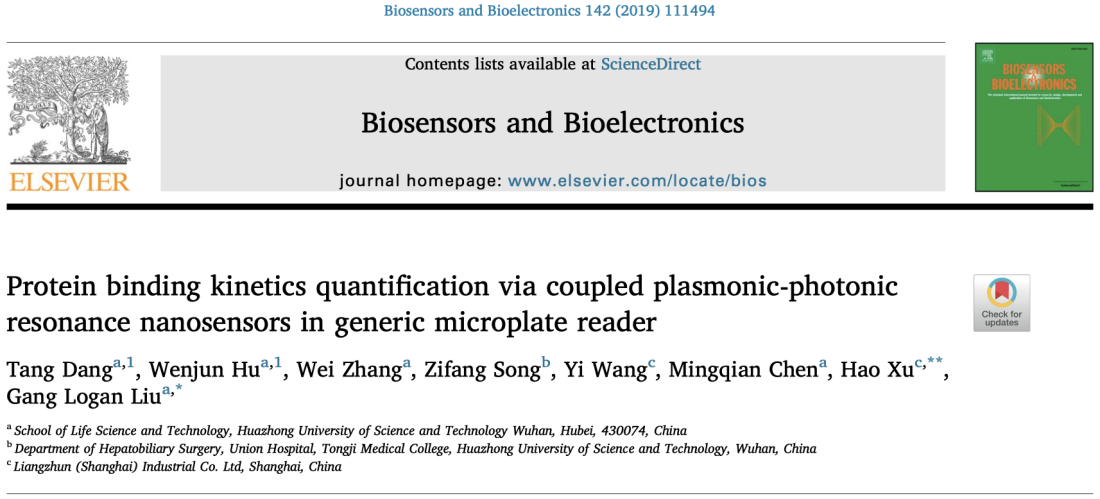(Correspondent Dandan Wang) A label-free, high-throughput and low-cost biosensor for the binding kinetics quantification of CRP in human blood serum based on nanoplasmonic sensor in microplate wells by generic plate reader is investigated by the team of Prof. Gang Logan Liu from College of Life Science & Technology, HUST. The relative research paper entitled “Protein binding kinetics quantification via coupled plasmonic-photonic resonance nanosensors in generic microplate reader” has been published on the journal of Biosensors and Bioelectronics (Top journal in Engineering technology, journal citation reports rank I of Chinese Academy of Sciences, IF: 9.518, ESI 10%).
Surface plasmon resonance (SPR) sensors such as the commercial Biacore SPR biosensor system are capable of real-time monitoring kinetic biomolecular interactions, requiring no labeling and unaffected by bulk background while collecting high quality time-lapse data of surface biomolecular and drug binding events. Conventional SPR sensors are typically gold or silver thin films deposited on glass or other dielectric substrate. Notably as a result of the surface molecular binding event, small plasmon resonance angle or resonance wavelength shifts due to a change in refractive index near the SPR sensor chip surface. Compared to conventional SPR, LSPR doesn't need a prism or other optical coupling device to excite and has higher surface-to-volume ratio. These features of LSPR sensors make it possible for detections in ubiquitous laboratory equipment.

In this paper, Liu’s team demonstrated a label-free LSPR biosensor in the 96-well plate format for dynamic measurements of CRP and anti-CRP antibody binding kinetics only using a ubiquitous generic microplate reader, and at the same time quantification of CRP concentration in buffer and blood serum was performed. They simply used antibody-target protein-antibody sandwich method in the 96-well LSPR sensor plate and measured the dynamic change of OD value by a generic microplate reader to carry out similar kinetic protein measurements in conventional SPR systems such as Biacore. They achieved detection of inflammation biomarker CRP with a LOD of 50 ng/ml which has full capacity of detecting CRP in blood serum with high consistency with from hospital test. Furthermore, the nanoplasmonic sensor microplate is also a powerful tool for studying dynamic protein interaction and measuring binding kinetics. We can realize similar functionality of commercial SPR systems by simply utilizing the ubiquitous microplate reader. The unique nanosensor plate combined with generic microplate reader may become a new technology platform for biomolecular interaction and kinetic study. It was possible to foresee that commercial applications of the technique will be widely used in the fields of food safety detection, environmental pollution test and disease screening.

The research was contributed by College of Life Science & Technology HUST, Liangzhun (Shanghai) Industrial Co. Ltd, Union Hospital of Tongji Medical College HUST, Wuhan Industrial Institute for Optoelectronic. The co-first authors of the publication are Dang tang (Master. Degree candidates) and Wenjun Hu (Associated Professor) from College of Life Science & Technology HUST.